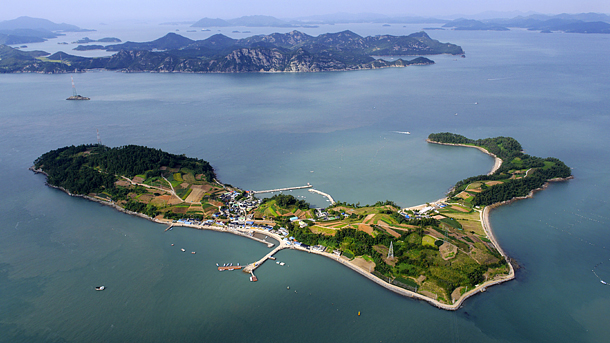Exploring the distinct island escapes of Goheung : South Jeolla county is a destination for art, food and natural sights

The aerial view of Yeonhong Island, which is transforming itself into an art-themed destination. [GOHEUNG COUNTY]
Enjoying what nature offers without the crowds pushing you left and right is certainly the biggest appeal of Goheung County, South Jeolla. Goheung is one of few counties in Korea that is comprised of many different islands which were once only accessible by boat. The remote area, which until recently has long been off the radar for most travelers, has become a hot spot for those looking for some quiet outside of the hustle and bustle found in the big cities.

Yeonhong Island is known for its attempts to make the island artsy. On the island is Yeonhong Art Museum, left, alongside many installations that mimic people’s movements, at middle, as well as a fish. [JANG JEONG-PIL]
Reaching serenity isn’t as difficult as it has been in the past, now that a number of newly constructed bridges provide easy access to the region. While it used to take at least two boat transfers to get to the more remote areas like Yeonhong Island, you now can access the larger islands by bridge, like Geogeum Island, and then catch a boat to get to smaller ones like Yeonhong. A boat ride to Yeonhong from Geogeum Island takes less than five minutes.
Yeonhong Island has received the most attention as the county has been working to transform the island with less than 100 residents into an art destination. The project started in 2015 and is ongoing with renovations here and there, as well as the construction of more lodging and dining options.
The island welcomes visitors stepping off the boat with a wall covered in photos. The around 400 photos, showing festive moments on the island, were donated by locals who live on the island to show the memories of the island and to inspire visitors to have similar moments during their time spent on the island.
Two large installations of shells and artwork behind them signal the island’s artistic atmosphere.
It isn’t hard to navigate on the island. One can just follow the painted walls towards the center of the island. There are different walking trails being developed, but even if you get lost, the island is small enough to find your bearings within a minute or two. A slow walk around the island may take up to an hour or so, depending on how many breaks you take in between.
Following the painted walls will take visitors to the other side of the island, where people can get a view of the rocky walls of Geumdang Island. The picturesque view is only available when the sun is in the east, so make sure to go into the island in the morning time if you want to add the view to part of your trip.
Walking along the coastline takes you to a Yeonhong Art Museum on the island. The museum was a school until 1998. The abandoned building was renovated into a small art museum in 2006. There are many works made with small stones and objects displayed in a small garden area right outside of the museum and there are about 120 artworks inside the building.
Although there is no art from renowned artists, the works there depict scenes or objects easily found on the island and visitors with all kinds of artistic background can enjoy. The official opening of the renovated museum is April 8. The museum also offers rooms for visitors to stay overnight.
The fare for the small boat to Yeonhong Island from Geogeum Island is 3,000 won ($2.68) for visitors. The boat runs seven times a day and detailed schedules are not available online, so visitors should check with the county office by phone beforehand. Rides for groups can be requested in advance as well.

Goheung has a lot of seafood to offer. At the top is a porridge made with octopus and red bean, and at top left is a bowl of oyster soup called pigul. Second from the top on the right is saejogae, and to its left is pijogae. The bottom is juggumi, a smaller-sized octopus marinated in spicy sauce. [LEE SUN-MIN]
Although the island doesn’t have much to offer when it comes to food, considering its small size, other restaurants close to downtown Goheung have options that are only available in the area. A food tradition widely found in Jeolla Province, known for its tasty side dishes that cover the entire table for a cheap price, can be found in Goheung as well. One can go to a restaurant and order a simple bowl of clam soup and be surprised with almost 10 different small side dishes made with seasonable vegetables and seafood for about 8,000 won, which is almost unthinkable in the Seoul metropolitan area.
A variety of seafood is in season in Goheung. A type of clam, called saejogae, is one of the most popular items in the spring. The name seajogae means bird clam, as its meat looks like the beak of a bird. The meat, which is famously thick and chewy attracts many food aficionados.
Another popular type of clam, ggomak, is widely found in the area as well. The more expensive chamggomak, which has deeper cuts on its shells than other triangle-shaped clams, is well-known for its savory taste. Usually the clam is lightly steamed and served in a marinade. The prices of these clams are different each year, depending on how much is available, and locals say this year the cost will be about 1,000 won per piece.
Octopus in Goheung is eaten as part of porridge. Locals here cook the octopus with rice and red beans, and the dish can be served at any local restaurant, as long as it is requested in advance. Another local favorite is an oyster dish called pigul. Although oysters taste best during the colder months, some restaurants still offer local recipes with oysters in the spring as long as good quality ones are still available. Oysters with shells are usually boiled with water, and the water is later is cooled separately and put together with shucked oyster. It was widely consumed in the area back in the day, but since it takes a long time to prepare, visitors need to check with the restaurant before their visit if such dish can be served.
If you are more interested in eating Korean style raw fish, try the Spanish mackerel. The fish, known for its oily and heavy flesh, tastes lighter and cleaner here.

From left: Terrace-style fields on the hillside of Goheung, which is widely found in the county. Mongdol Beach, often known as Dragon Egg Beach due to its round rocks on the beach, is a popular spot to visit for those wanting to take a dip in the sea. Yongbawi, or Dragon Rock, is where many come and wish for good things to come, as the spot is thought to be where dragon once ascended to the sky. [GOHEUNG COUNTY, LEE SUN-MIN]
Geogeum Island, which connects the inland to other smaller islands nearby is known for its road along the coastline. One can simply get in a car and make a multiple stops here and there to appreciate the view.
The island has Mongdol Beach, where both sand and round rocks can be found. The rocks work as natural chairs to sit on but also as a unique backdrop for photos. The rocks are so round and large, the beach has earned its nickname as the beach with dragon eggs.
Another spot to stop at is Yongbawi, which translates to dragon rock. As if a dragon has appeared from the water and climbed the stone, there are scratch marks that are speculated to have been made with the claws of a dragon, according to the area’s long-held myth.
Many locals come here to wish for their well-being. The rocky wall is worth taking a look at for a while, but many don’t stay here too long as the area doesn’t have much of a seating area or shade.
For some greenery, look for the terrace-style paddies. Due to the steep hillside found in many areas around Goheung, these types of fields are commonly seen on the island.
Out of Geogeum Island, there still is one more place one should stop by, especially during the spring. Inhak Village has one of the largest plum tree fields in Korea, and is lesser known than other farms with plum trees such as Gwangyang, also in South Jeolla.
The flowers are in full bloom now and will continue to stay a little longer. Visitors will also see many bees working hard to gather nectar from the flowers all around. The farm plays classical music through a speaker to create a spring-like atmosphere while appreciating the flowers.
BY LEE SUN-MIN [summerlee@joongang.co.kr]










with the Korea JoongAng Daily
To write comments, please log in to one of the accounts.
Standards Board Policy (0/250자)